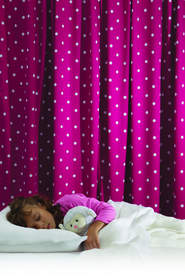MISSION, KS--(Marketwire - November 29, 2010) - (Family Features) Parents of newborns can't wait for the baby to sleep through the night, but sleeping through the night can be a problem for children of any age, from birth through their teen years. Even naptime can present a challenge, with a number of daytime sounds and distractions preventing the baby from getting the uninterrupted sleep a parent hopes for.
Sleep is vital to a child's health and growth, but what can parents do to help promote quality sleep?
While a child's sleep-needs vary as they grow, there are two recommendations that remain consistent, no matter the child's age. The National Sleep Foundation (NSF) recommends maintaining a regular bedtime routine and a sleep-friendly environment.
"Three of the biggest influences on sleep are noise, temperature and light," said Jonathan Sadinoff, spokesperson for LightCatcher Curtains, "so maintaining a sleep-friendly environment means controlling those elements as much as possible and keeping them consistent." In fact, the American Academy of Pediatrics recommends a cool, dark and quiet room as the best environment for sleeping.
Here are some things you can do to make your child's room sleep-friendly and help them get the rest they need.
Noise. Busy traffic, noisy appliances, or even the barking of neighborhood dogs can interrupt a child's sleep. Children don't need complete silence to sleep, but minimizing excess sound can help them fall asleep and stay asleep. The white noise of a fan or air conditioner can help block unwanted sound. Carpet, upholstery and blackout curtains can also absorb some of the ambient noise and make the room quieter.
Temperature. There isn't an ideal temperature for sleep -- the point at which temperature conditions interrupt sleep will be different for everyone. But in most cases, the NSF says that temperatures above 75 degrees and below 54 degrees will disrupt sleep. A slightly cooler room contributes to good sleep because it mimics what happens when the body's internal temperature drops to its lowest level during the night. Monitor your child's room for temperature. Rooms with more sun exposure tend to be warmer and may need a fan.
Light. The human body is sensitive to light, even while sleeping. The Better Sleep Council (BSC) says that light, such as the rising sun, is a powerful cue to the body and can wake up the brain well before the alarm clock sounds. Keeping the room as dark as possible helps the body fall asleep naturally. The BSC recommends getting as much exposure to sunlight during the day as possible, and to block as much light as possible during sleeping hours to keep the body on track.
Both the BSC and the NSF recommend the use of light blocking curtains. Blackout curtains, such as those made by LightCatcher, can help turn the bedroom into the sleep sanctuary children need. Because traditional-width curtains can leak light from the top and sides, LightCatcher blackout curtains are cut wide, in over 50-inch widths, providing more light prevention. With exclusive Insuldark technology, these curtains also provide more sound dampening and more energy savings than traditional curtains, helping to keep the room not only dark enough, but cool and quiet enough for good sleep. LightCatcher curtains are available at buybuybaby.com.
How Much Sleep Do They Need?
While there is variability between each of us in how much sleep we need, the National Sleep Foundation (NSF) has noted that the need for sleep changes as we age. The NSF has recommended the following sleep guidelines for selected age groups:
| Newborns (0-2 months) | 12-18 hours |
| Infants (3-11 months) 14-15 hours | |
| Toddlers (1-3 years) | 12-14 hours |
| Preschoolers (3-5 years) | 11-13 hours |
| School-Age Children (5-10 years) | 10-11 hours |
| Teens (10-17) | 8.5-9.25 hours |
Find out more at www.sleepfoundation.org.
Healthy Bedtime Routines
Here are some tips from Sleepforkids.org for helping children develop bedtime routines that will help them get to sleep:
Sleep Tips for Infants
- Develop regular daytime and bedtime schedules.
- Create a consistent and enjoyable bedtime routine.
- Establish a regular "sleep friendly" environment.
- Encourage baby to fall asleep independently and to become a "self-soother."
Sleep Tips for Toddlers
- Maintain a daily sleep schedule and consistent bedtime routine.
- Make the bedroom environment the same every night and throughout the night.
- Set limits that are consistent, communicated and enforced. Encourage use of a security object such as a blanket or stuffed animal.
Sleep Tips for Preschoolers
- Maintain a regular and consistent sleep schedule.
- Have a relaxing bedtime routine that ends in the room where the child sleeps.
- Child should sleep in the same sleeping environment every night, in a room that is cool, quiet and dark -- and without a TV.
Sleep Tips for School-aged Children
- Teach school-aged children about healthy sleep habits.
- Continue to emphasize need for regular and consistent sleep schedule and bedtime routine.
- Make child's bedroom conducive to sleep -- dark, cool and quiet.
- Keep TV and computers out of the bedroom.
- Avoid caffeine.
